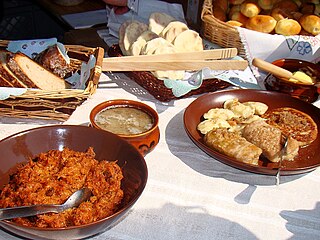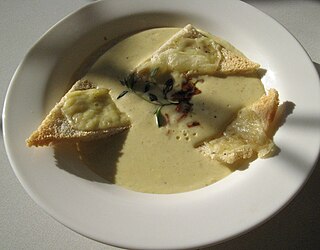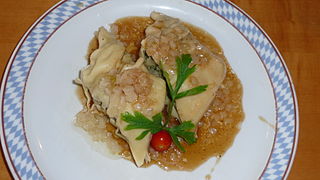



This is a list of notable Italian soups . Soups are sometimes served as the primo (first course) in Italian cuisine. In some regions of Italy, such as Veneto, soup is eaten more than pasta. [1]




This is a list of notable Italian soups . Soups are sometimes served as the primo (first course) in Italian cuisine. In some regions of Italy, such as Veneto, soup is eaten more than pasta. [1]

Minestrone is a thick soup of Italian origin made with vegetables and beans, and sometimes pasta or rice. It typically includes onions, celery, carrots, leaf vegetables, stock, Parmesan cheese, and tomatoes. Minestrone traditionally is made without meat, but it has no set recipe and can be made with many different ingredients.

Polish cuisine is a style of food preparation originating in and widely popular in Poland. Due to Poland's history, Polish cuisine has evolved over the centuries to be very eclectic, and shares many similarities with other national cuisines. Polish cooking in other cultures is often referred to as à la polonaise.

Italian wedding soup, known in Italian as minestra maritata, is a soup consisting mainly of green vegetables and meat in chicken broth. It is popular in the United States, where it is a staple in many Italian restaurants and diners.

Peasant foods are dishes eaten by peasants, made from accessible and inexpensive ingredients.

Italian cuisine is a Mediterranean cuisine consisting of the ingredients, recipes, and cooking techniques developed in Italy since Roman times and later spread around the world together with waves of Italian diaspora. Significant changes occurred with the colonization of the Americas and the introduction of potatoes, tomatoes, capsicums, maize, and sugar beet—the latter introduced in quantity in the 18th century. It is one of the best-known and most appreciated gastronomies worldwide.

Ribollita is a Tuscan bread soup, panade, porridge or potage made with bread and vegetables, often from leftovers. There are many variations, but the usual ingredients include leftover bread, cannellini beans, lacinato kale, cabbage and inexpensive vegetables such as carrot, beans, chard, celery, potatoes and onion. It is often baked in a clay pot.

Neapolitan cuisine has ancient historical roots that date back to the Greco-Roman period, which was enriched over the centuries by the influence of the different cultures that controlled Naples and its kingdoms, such as that of Aragon and France.

Soup is a primarily liquid food, generally served warm or hot, that is made by combining ingredients of meat or vegetables with stock, milk, or water. Hot soups are additionally characterized by boiling solid ingredients in liquids in a pot until the flavors are extracted, forming a broth. Soups are similar to stews, and in some cases there may not be a clear distinction between the two; however, soups generally have more liquid (broth) than stews.

Cheese soup is a type of soup prepared using cheese as a primary ingredient, along with milk, broth and/or stock to form its basis. Various additional ingredients are used in its preparation, and various types and styles of cheese soup exist. It is a part of some cuisines in the world, such as American, Colombian, Mexican, Swiss, French, and Tibetan cuisines. Mass-produced cheese soups may be prepared with the addition of food additives to preserve them and enhance flavor. A list of cheese soups is included in this article.

Bread soup is a simple soup that mainly consists of stale bread. Variations exist in many countries, and it is often eaten during Lent. Both brown and white bread may be used.

Swabian cuisine is native to Swabia, a region in southwestern Germany comprising great parts of Württemberg and the Bavarian part of Swabia. Swabian cuisine has a reputation for being rustic, but rich and hearty. Fresh egg pastas, soups, and sausages are among Swabia's best-known types of dishes, and Swabian cuisine tends to require broths or sauces; dishes are rarely "dry".

Zuppa toscana, also known in Italy as minestra di pane, is a soup from the region of Tuscany, northern Italy. While there are many variations, its most common ingredients are cannellini beans, potatoes, and kale.

Acquacotta is a hot broth-based bread soup in Italian cuisine that was originally a peasant food. Its preparation and consumption dates back to ancient history, and it originated in the coastal area known as the Maremma, in southern Tuscany and northern Lazio. The dish was invented in part as a means to make hardened, stale bread edible. In contemporary times, ingredients can vary, and additional ingredients are sometimes used. Variations of the dish include acquacotta con funghi and acquacotta con peperoni.
Garmugia, also referred to as gramugia, is an Italian soup originally from the town of Lucca, Tuscany. The soup's use in the cuisine of Lucca dates back to the 17th century. Garmugia has been described as "a hearty soup" that is "unknown outside of the province" in Italy.

The cuisine of Basilicata, or Lucanian cuisine, is the cuisine of the Basilicata region of Italy. It is mainly based on the use of pork and sheep meat, legumes, cereals and vegetables, with the addition of aromas such as hot peppers, powdered raw peppers and horseradish. The local gastronomy is, for historical-cultural reasons, typically peasant, based on simple recipes and on the culture of reuse, in particular of meat and bread.

Onion soup is a type of vegetable soup with sliced onions as the main ingredient. It is prepared in different variations in many countries, the most famous of which is the French onion soup or Parisian onion soup. Because of the affordable ingredients, it has primarily been a dish for the poor for a long time.